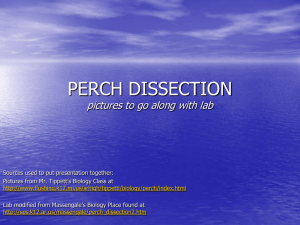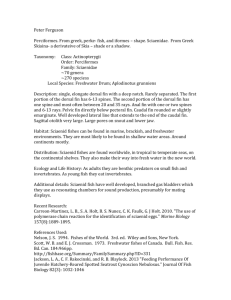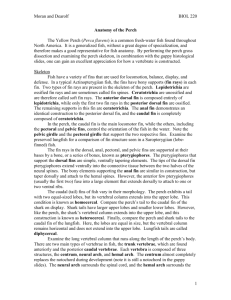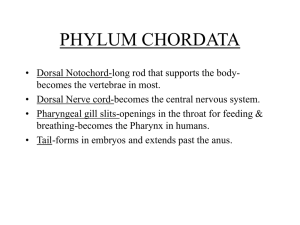Perch Dissection - APBiologyIsSuper
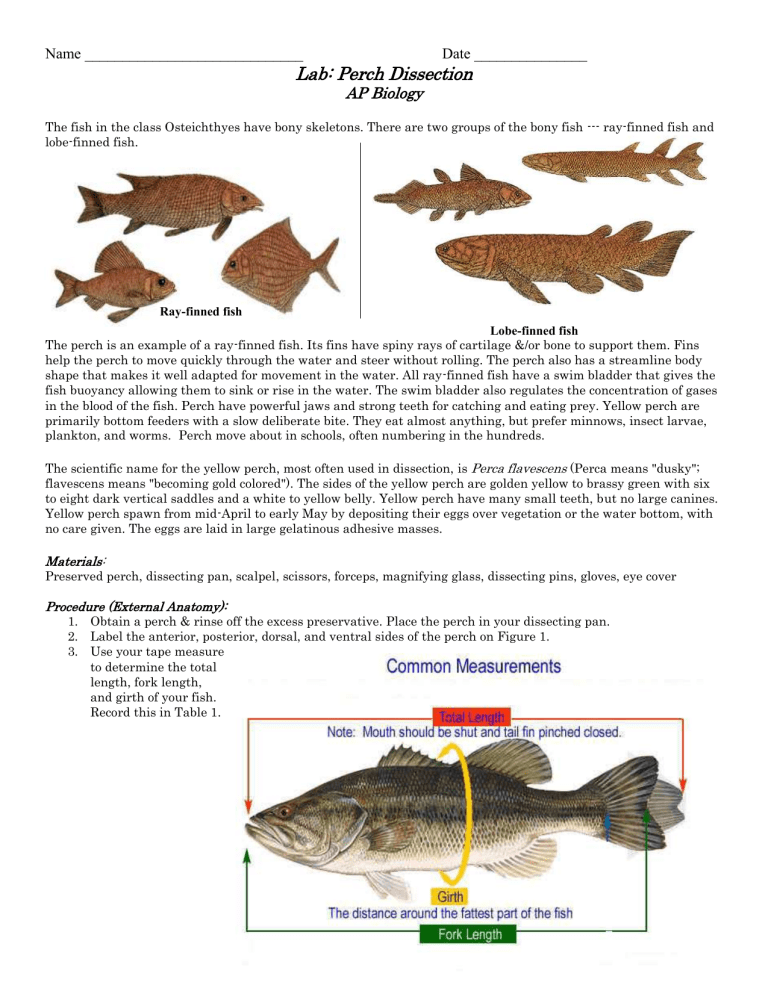
Name _____________________________ Date _______________
Lab: Perch Dissection
AP Biology
The fish in the class Osteichthyes have bony skeletons. There are two groups of the bony fish --- ray-finned fish and lobe-finned fish.
Ray-finned fish
Lobe-finned fish
The perch is an example of a ray-finned fish. Its fins have spiny rays of cartilage &/or bone to support them. Fins help the perch to move quickly through the water and steer without rolling. The perch also has a streamline body shape that makes it well adapted for movement in the water. All ray-finned fish have a swim bladder that gives the fish buoyancy allowing them to sink or rise in the water. The swim bladder also regulates the concentration of gases in the blood of the fish. Perch have powerful jaws and strong teeth for catching and eating prey. Yellow perch are primarily bottom feeders with a slow deliberate bite. They eat almost anything, but prefer minnows, insect larvae, plankton, and worms. Perch move about in schools, often numbering in the hundreds.
The scientific name for the yellow perch, most often used in dissection, is
Perca flavescens
(Perca means "dusky"; flavescens means "becoming gold colored"). The sides of the yellow perch are golden yellow to brassy green with six to eight dark vertical saddles and a white to yellow belly. Yellow perch have many small teeth, but no large canines.
Yellow perch spawn from mid-April to early May by depositing their eggs over vegetation or the water bottom, with no care given. The eggs are laid in large gelatinous adhesive masses.
Materials:
Preserved perch, dissecting pan, scalpel, scissors, forceps, magnifying glass, dissecting pins, gloves, eye cover
Procedure (External Anatomy):
1.
Obtain a perch & rinse off the excess preservative. Place the perch in your dissecting pan.
2.
Label the anterior, posterior, dorsal, and ventral sides of the perch on Figure 1.
3.
Use your tape measure to determine the total length, fork length, and girth of your fish.
Record this in Table 1.
Table 1 - Fish Measurements (inches)
Total Length
Fork Length
Girth
4.
Locate the 3 body regions of the perch --- head, trunk, and tail. Label these on Figure 1.
5.
Open the perch's mouth and observe its bony jaws. Locate and label the upper jaw or maxilla and the lower jaw or mandible.
6.
Feel the inside of the mouth for the teeth. Locate & label the tongue & teeth on Figure 1.
7.
Open the mouth wider and use a probe to reach back to the gill chamber.
8.
Locate the nostrils and label on Figure 1.
9.
Locate and note the location of the eyes. Label on Figure 1.
10.
Find the bony covering on each side of the fish's head called the operculum. The opercula cover & protect the gills. Label these on Figure 1.
Figure 1 - External Perch anatomy
11.
Use a probe to lift the operculum and observe the gills. Note their color.
12.
Use a scissors to cut away one operculum to view the gills. Find the gill slits or spaces between the gills.
13.
Use your scissors to carefully cut out one gill. Find the cartilage support called the gill arch and the soft gill filaments that make up each gill. Label the parts of the gill in Figure 2.
Figure 2 - Gill Structure
14.
Observe the different fins on the perch. Locate the pectoral, dorsal, pelvic, anal, and caudal fins. Note whether the fin has spines. Label these on Figure 1 and complete Table 2 on fins.
Name of Fin
Spines
(yes or no)
Table 2 - Fins
Number of Fins Location Function
15.
Locate the anus on the perch anterior to the anal fin. In the female, the anus is in front of the genital pore, and the urinary pore is located behind the genital pore. The male has only one pore (urogenital pore) behind the anus. Determine the sex of your perch.
16.
Find the lateral line on the side of your perch. Label this line on Figure 1. What does the lateral line do?
17.
Use forceps to remove a few scales from your fish. Observe the scales under the magnifying glass. Sketch a scale on Figure 3.
18.
Count the growth rings on your scale to tell the age of your fish. (Hint: each group of rings represents one year's growth.)
Figure 3 – structure of a scale
Procedure (Internal Anatomy):
1.
Use dissecting pins to secure the fish to the dissecting pan. Use scissors to make the cuts through skin and muscle shown in Figure 4.
Figure 4 - Cut Lines for Internal dissection
2.
After making the cuts, carefully lift off the flap of skin and muscle to expose the internal organs in the body cavity.
3.
Locate the cream colored liver in the front of the body cavity. You may also see the gallbladder between the lobes of the liver. Label the liver on Figure 5.
4.
Remove the gall bladder & liver to observe the short esophagus attached to the stomach. Label the stomach on Figure 5
5.
At the posterior end of the stomach are the coiled intestines. Locate and then label these on Figure 5.
6.
Find the small reddish brown spleen near the stomach and label this on Figure 5.
7.
Below the operculum, are the bony gill rakers. Locate these & them label them on Figure 5.
8.
In front of the liver & behind the gill rakers is the pericardial cavity containing the heart. The heart of a fish only has 2 chambers --- an atrium & and a ventricle. Locate the heart & label it on Figure 5.
9.
In the upper part of the body below the lateral line is the swim bladder. This sac has a thin wall and gives the fish buoyancy. Label the swim bladder on Figure 5.
10.
Below the swim bladder are the gonads, testes or ovaries. In a female, these may be filled with eggs. Label the gonads on Figure 5.
11.
Find the 2 long, dark kidneys in the posterior end of the perch. These filter wastes from the blood. Label the kidneys in Figure 5.
12.
Wastes exit the body through the vent located on the ventral side of the perch. Label this structure on fig 5.
Figure 5 - Internal Perch Anatomy
Questions & Observations:
1.
Are both jaws of the fish equally movable? Explain your answer.
2.
Does the perch have eyelids?
3.
How many gills are located on each side of the perch? What covering protects them?
4.
What is the function of the gill rakers?
5.
Explain how gas exchange occurs at the gills.
6.
Which fin was the largest? What other difference do you notice in this fin when it was compared to the others?
7.
What was the sex of your fish?
8.
What is the function of the lateral line?
9.
Describe how the scales are arranged on the trunk & tail of your fish.
10.
Explain how the swim bladder controls buoyancy.
Part 2: Classification of Bony Fish
Problem: You and a several friends are going fishing. The lake has many different kinds of fish. However brook trout, pickerels, and wall-eyed pike are protected and there is a $500 fine for keeping these fish. Instead of memorizing the names of all the fish, it is easier to use a taxanomic key.
Procedures:
1.
Use the dichotomous key on the next page to determine which numbers to help you determine the name of the fish.
2.
Begin identification of each fish by reading choices 1a and 1b. Determine which choice is more descriptive of the pictured fish (not all the characteristics listed are clearly visible, but do your best). Follow the instructions given at the right side of the paper; they will direct you to another step or tell you the name of the fish.
3.
Record each fish’s identity in the table below.
Fish number Fish name
1
8
9
10
11
12
13
14
5
6
7
2
3
4
15
16
17
18
Conclusion:
1.
What are some limitations when using a dichotomous key?
2.
Error analysis and suggestions
Classification Key to Certain Fish
** All measurements do not include fins.
1a. Body noticeably covered with scales ....................................................................................................2
1b. Scales not present or too small to be seen...........................................................................................12
2a. Dorsal fin single .................................................................................................................................3
2b. Dorsal fins two or more, joined or separated ....................................................................................... 6
3a. Body more than five times as long as broad; front edge of dorsal fin far back on body; mouth large, hinge of mouth is behind eye....................................................................4
3b. Body less than five times as long as broad; front edge of dorsal fin about midway between head and tail; mouth not large, hinge of mouth is in front of eye ............................................5
4a. Dark lines forming netted design on body, fins not spotted.......................................................
4b. Body covered with yellow spots; fins spotted ..................................................................
5a. Mouth turned downward; barbels absent; dorsal fin not elongated....................................
Pickerel
Northern pike
White sucker
5b. Mouth not turned downward; barbels present; dorsal fin elongated ..............................................
Carp
6a. Two dorsal fins separated, the anterior spiny and the posterior soft .....................................................7
6b. Two dorsal fins united, forming an anterior spiny portion and a posterior soft portion ........................................................................................................................ 8
7a. Top of head concave, forming a hump in front of dorsal fin; dark vertical bars on body .................................................................................................
7b. Top of head not concave, body sloping to dorsal fin and not forming a hump; dark blotches on body.......................................................................................
Yellow perch
Wall-eyed pike
8a. Body more than three times as long as broad ...................................................................................... 9
8b. Body less than three times as long as broad ...................................................................................... 10
9a. Hinge of jaws behind the eye; notch between spiny and soft dorsal fin deep nearly separating into two fins.................................................................
9b. Hinge of jaws in front of or below the eye; notch between spiny and soft dorsal fin not nearly separating into two fins.....................................
Large mouth black bass
Small mouth black bass
10a. Mouth large, hinge below or behind eye.............................................................................................11
10b. Mouth small, hinge in front of eye..............................................................................................
11a. Five to seven spines in dorsal fin; dark spots forming broad vertical bars on sides.............................................................................................
White crappie
11b. Ten or more spines in dorsal fin; sides flecked with dark spots...............................
Rock bass (Redeye)
12a. Body much elongated and snake-like; dorsal, caudal and anal fins continuous..................................
12b. Body not elongated and snake-like; dorsal, caudal and anal fins separate; adipose fin present ................................................................................................13
13a. Barbel growing from lips and top of head; head large and broad ......................................................14
13b. Barbels lacking; head not large and broad ......................................................................................... 16
14a. Caudal fin deeply forked; head tapering............................................................................................. 15
14b. Caudal fin rounded or slightly indented but not forked; head blunt.............................
Bullhead catfish
15a. Dorsal fin rounded at top; body silvery, speckled with black markings...........................
16a. Caudal fin deeply forked; back not mottled and with few spots.......................................
Channel catfish
15b. Dorsal fin long and pointed at the top; body bluish-gray without speckles ..........................
17a. Back and caudal fin spotted; broad horizontal band along sides........................................
Bluegill
Eel
Blue catfish
Atlantic salmon
16b. Caudal fin square or slightly indented; back mottled or spotted...........................................................17
Rainbow trout
17b. Back mottled with dark lines; caudal fin not spotted .............................................................
